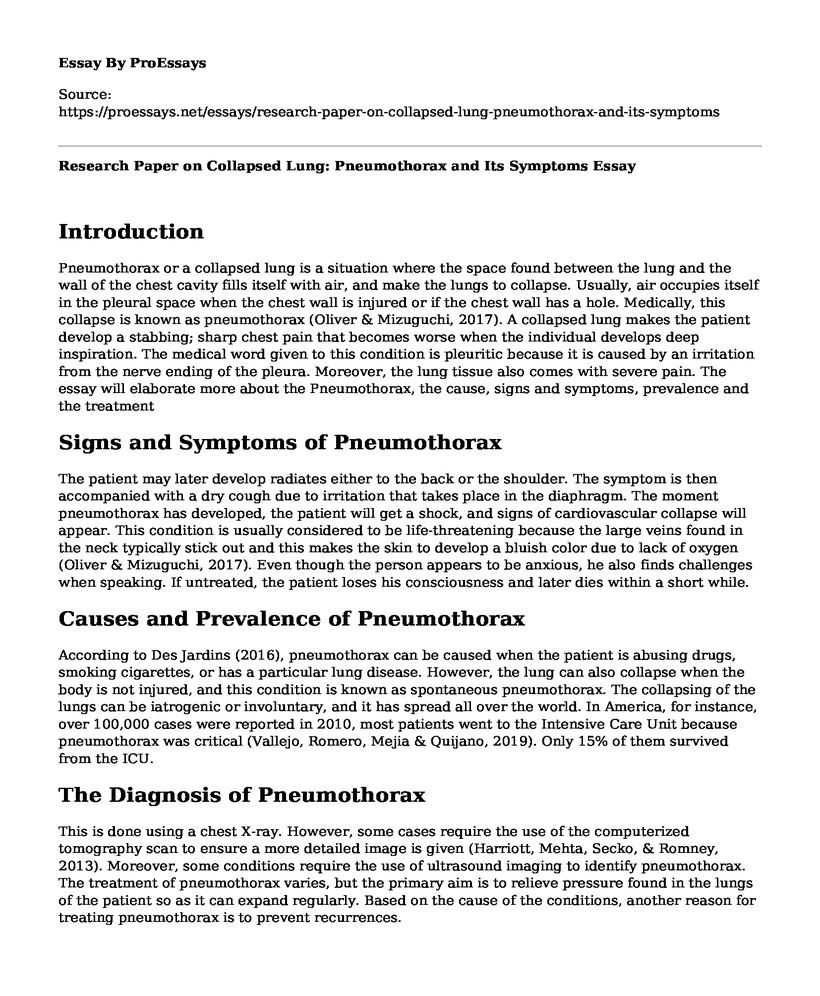Introduction
Pneumothorax or a collapsed lung is a situation where the space found between the lung and the wall of the chest cavity fills itself with air, and make the lungs to collapse. Usually, air occupies itself in the pleural space when the chest wall is injured or if the chest wall has a hole. Medically, this collapse is known as pneumothorax (Oliver & Mizuguchi, 2017). A collapsed lung makes the patient develop a stabbing; sharp chest pain that becomes worse when the individual develops deep inspiration. The medical word given to this condition is pleuritic because it is caused by an irritation from the nerve ending of the pleura. Moreover, the lung tissue also comes with severe pain. The essay will elaborate more about the Pneumothorax, the cause, signs and symptoms, prevalence and the treatment
Signs and Symptoms of Pneumothorax
The patient may later develop radiates either to the back or the shoulder. The symptom is then accompanied with a dry cough due to irritation that takes place in the diaphragm. The moment pneumothorax has developed, the patient will get a shock, and signs of cardiovascular collapse will appear. This condition is usually considered to be life-threatening because the large veins found in the neck typically stick out and this makes the skin to develop a bluish color due to lack of oxygen (Oliver & Mizuguchi, 2017). Even though the person appears to be anxious, he also finds challenges when speaking. If untreated, the patient loses his consciousness and later dies within a short while.
Causes and Prevalence of Pneumothorax
According to Des Jardins (2016), pneumothorax can be caused when the patient is abusing drugs, smoking cigarettes, or has a particular lung disease. However, the lung can also collapse when the body is not injured, and this condition is known as spontaneous pneumothorax. The collapsing of the lungs can be iatrogenic or involuntary, and it has spread all over the world. In America, for instance, over 100,000 cases were reported in 2010, most patients went to the Intensive Care Unit because pneumothorax was critical (Vallejo, Romero, Mejia & Quijano, 2019). Only 15% of them survived from the ICU.
The Diagnosis of Pneumothorax
This is done using a chest X-ray. However, some cases require the use of the computerized tomography scan to ensure a more detailed image is given (Harriott, Mehta, Secko, & Romney, 2013). Moreover, some conditions require the use of ultrasound imaging to identify pneumothorax. The treatment of pneumothorax varies, but the primary aim is to relieve pressure found in the lungs of the patient so as it can expand regularly. Based on the cause of the conditions, another reason for treating pneumothorax is to prevent recurrences.
Treatment
Methods used for treatment depend on how severe the lungs collapsed as well as the health of the patient. Usually, the treatment of pneumothorax includes needle aspiration, non-surgical repair, chest tube insertion, and observations. However, if a small portion of the lungs has collapsed, the doctor observes the patient's condition by using chest X-rays series to make sure that the air is absorbed and the lung has suppressed (Harriott et al., 2013). If the chest does not have a lung collapses after treatment, non-surgical options become the best to avoid air leakage. Doctors use substances that irritate the tissues that have formed around the lung to make them stick together so that they may seal any leaks.
Conclusion
Pneumothorax or a collapsed lung is a situation where the space found between the lung and the wall of the chest cavity fills itself with air. Usually, the collapsing of the lungs can be iatrogenic or spontaneous and make it spread all over the world. Often, this condition is considered to be life-threatening because the large veins found in the neck stick out, and this makes the skin to develop a bluish color due to lack of oxygen. A collapsed lung makes the patient develop a stabbing; sharp chest pain that becomes worse when the individual develops deep inspiration. Most treatments depend on how severe the lungs are, as well as the health of the patient.
References
Harriott, A., Mehta, N., Secko, M., & Romney, M. S. (2013). Sonographic diagnosis of bilateral pneumothorax following an acupuncture session. Journal of Clinical Ultrasound, 42(1), 27-29.
Vallejo, A. G., Romero, R., Mejia, M., & Quijano, E. (2019). Primary Spontaneous Pneumothorax, a Clinical Challenge. Retrieved from https://www.intechopen.com/online-first/primary-spontaneous-pneumothorax-a-clinical-challenge doi:10.1002/jcu.22046
Des Jardins. T (2016). Clinical Manifestations and Assessment of Respiratory Disease, 7th Ed., 2016, Elsevier.
Oliver, J., & Mizuguchi, K. A. (2017). Pneumothorax. Oxford Medicine Online, 29(5), 227-236. doi:10.1093/med/9780190226459.003.0021
Cite this page
Research Paper on Collapsed Lung: Pneumothorax and Its Symptoms. (2023, Jan 24). Retrieved from https://proessays.net/essays/research-paper-on-collapsed-lung-pneumothorax-and-its-symptoms
If you are the original author of this essay and no longer wish to have it published on the ProEssays website, please click below to request its removal:
- The Scale of America's Opioid Epidemic Is Shocking
- Assignment Example on Responsive Intervention for a Hispanic Client
- Drama in the Lakers Boardroom Case Study Paper Example
- The Effectiveness of Surveillance Systems in Monitoring Cancer in the United States Paper Example
- The Head Start Policy Program Evaluation Paper Example
- Essay on Consumers' Pursuit of Sustainable Food Products: A New Era in the Food Industry
- Essay Example on Comparing Nursing Degrees for RN Licensure







